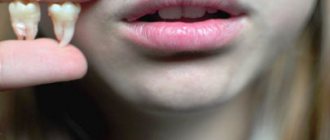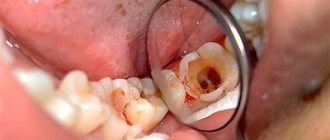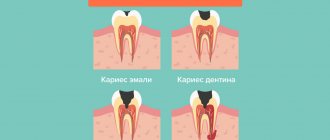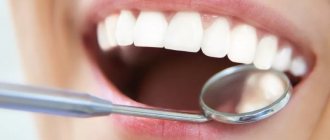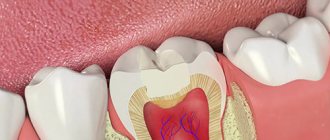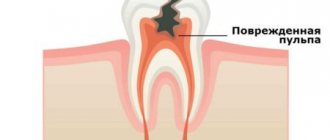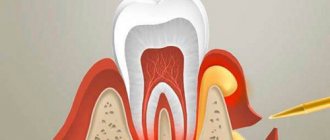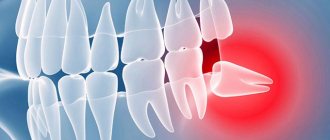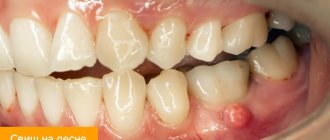Pulpitis of the tooth and its treatment
A characteristic sign of this pathology is inflammation in the pulp, which is located inside the tooth cavity, where blood vessels and nerves are concentrated. The cause of inflammation is the penetration of harmful bacteria into the cavity due to damage to the external dental tissues (enamel and dentin). This is the destruction that we most often owe to untimely treatment of deep dental caries: pulpitis becomes a consequence of the carious process. Much less often, it appears due to mechanical damage to the pulp, poor preparation of the tooth for filling, and unprofessional installation of orthopedic structures.
Treatment methods for pulpitis
In dentistry, two main methods are used to treat dental pulpitis in adults and children:
- biological - drug treatment of pulpitis with antibiotics and medications;
- surgical - treatment of pulpitis by amputation (partial removal of the pulp) or extirpation (in which the nerve of the tooth is completely removed).
The choice of technique remains with the dentist. The doctor studies X-ray diagnostic data, interviews and examines the patient. Based on these data, he selects the most rational method of treating pulpitis for a particular case.
How does tooth pulpitis occur and develop?
To understand the essence of the disease, it will be useful to familiarize yourself in detail with the structure of the tooth. The top layer of the tooth is durable enamel, which acts as protection for hard tissues and sensitive epithelium - the pulp. The pulp contains large quantities of tiny capillaries and nerve fibers; its key function is to ensure complete saturation of tooth tissue with oxygen, vitamins and macroelements. The pulp chamber, hidden by dentin, is sealed, but if caries severely destroys the tooth, this seal is broken and the inflammatory process quickly spreads to the vulnerable pulp. This process is called tooth pulpitis in dentistry. The main cause of pulpitis is the penetration of pathogenic bacteria into the pulp chamber. This usually occurs when there is severe tooth decay caused by advanced caries.
That is why dentists recommend to all their patients not to leave even a small carious spot on a tooth unattended - treatment of caries in the initial stage will be much less painful and simpler than treatment of tooth pulpitis.
Less commonly, tooth pulpitis occurs due to trauma, when infection penetrates through periodontal pockets, or through infection through the blood (in some general diseases of the body). USEFUL TO KNOW: Poor quality dental treatment can lead to the development of pulpitis. If the dentist makes a mistake in the process of filling the canals, or injures the pulp bundle with an instrument, the risks of an inflammatory reaction affecting the pulp seriously increase. For this reason, it is recommended to undergo dental treatment exclusively in clinics that value their reputation among patients and employ qualified specialists on their staff.
Depending on how exactly tooth pulpitis develops, different forms of the disease are distinguished. Depending on the form of pulpitis that is diagnosed during a visit to the dental clinic, the optimal method of treatment is selected.
Biological method of treating pulpitis
If the disease has become chronic, a biological method or conservative treatment of pulpitis with calcium is used. The process involves applying therapeutic pads containing calcium preparations. The technique is also used in the following cases:
- if the pulp was accidentally exposed during the caries treatment procedure;
- when you need to strengthen the bone partition between tooth enamel and pulp.
The specialist applies a drug for the treatment of pulpitis to the site of thinning bone tissue and thereby strengthens it. Next, the tooth is filled and monitored over time, conducting X-ray examinations at certain time intervals. The method is suitable:
- children with baby teeth;
- patients under 30 years of age during the treatment of reversible pulpitis;
- everyone who takes special care of their oral cavity.
If, after treatment of pulpitis, the tooth aches, hurts when pressed or bitten, and the pain remains for a long time, intensifies at night, and becomes long-lasting, you must return to the clinic. Aching pain during the treatment of pulpitis indicates that more radical, that is, surgical, methods are needed.
Tooth nerve removal
Removing tooth pulpitis includes several stages:
- Removal of tooth enamel and the subsequent hard layer of dentin.
- Removal of the tooth nerve, which is performed using a special instrument.
- Preparing dental canals for filling. To do this, the canals are expanded using a drill. Treatment of pulpitis may be accompanied by one-, two-, or three-channel filling.
- After removing and filling the canals, the dentist installs a photopolymer filling and restores the damaged coronal part.
Removal of tooth pulpitis is carried out with mandatory local anesthesia, which makes it possible to minimize the patient’s discomfort and discomfort during medical procedures.
How is pulpitis treated surgically?
As we have already noted, there are two possible options for surgical intervention:
- treatment of pulpitis using the amputation method with partial preservation of the pulp;
- treatment with complete removal of soft tissues, blood vessels, and nerves.
If there is an objective possibility, the doctor will remove only the top of the pulp - from the crown, leaving the root part. The blood supply and sensitivity (innervation) of the tooth will be preserved. The technique is used in the treatment of children - for milk or permanent teeth that have not yet fully grown. This allows them to form normally in the future. Treatment for pulpitis can be carried out in one visit.
Treatment price
Prices for treatment of pulpitis in Moscow at the InWhite Medical clinic are calculated individually in accordance with the complexity of the disease and the scale of the lesion. On this page you can see a sign with approximate prices for the treatment of pulpitis. In each specific case, we develop a plan of therapeutic measures, optimally selecting the necessary materials and methods.
| Service | Price |
| Primary appointment (examination, consultation) with a dentist | 2 000 ₽ |
| Orthopantomography (OPTG) | 1 900 ₽ |
| Teleradiography (TRG) | 1 900 ₽ |
Treatment of acute pulpitis
The above methods are ineffective in treating exacerbations of chronic pulpitis, an acute disease when the tooth becomes a source of unbearable pain radiating to the ear, temple, and back of the head. With these symptoms, endodontic treatment of pulpitis is carried out - with cleaning of the root canals and complete removal of the pulp.
In dentistry, two modern methods of treating tooth canals for pulpitis are used: devital and vital.
- Treatment of pulpitis using the vital amputation method is carried out by removing the nerve, washing, cleaning and filling the canal.
- Devital treatment of pulpitis involves the use of medicinal pastes and requires several sessions.
These treatment methods are most often used for pulpitis on permanent teeth.
Symptoms of tooth pulpitis
How can you determine that your tooth hurts precisely because of the development of pulpitis? This disease has its own characteristic symptoms and the first sign of the development of pulpitis may be pain that occurs when a diseased tooth comes into contact with cold/hot, sweet/sour foods. Unlike pain during caries, these sensations do not go away immediately after the irritant that caused them is eliminated: they persist for longer than 15 minutes. If you are bothered by such sensations during and after eating, you need to urgently contact your dentist for diagnosis and treatment of pulpitis.
It is important to understand that without proper treatment, pulpitis will not go away: the inflammatory process will continue to develop and this will lead to the transition of pulpitis to an acute form. In acute pulpitis, pain can occur suddenly and on its own, without external influence. Pus collects in the pulp, and if there is no natural outlet for its outflow, it begins to put pressure on the bundle of nerves, and severe pain occurs.
At first, this pain can be eliminated by taking tablets from the pharmacy, but if treatment for pulpitis is not carried out, pharmacy painkillers will no longer help. The pain will be excruciating and constant, moreover, it can spread along the nerve endings to different parts of the oral cavity. For this reason, people who go to the doctor for treatment of acute pulpitis often cannot pinpoint exactly which tooth is hurting. In acute pulpitis, swelling of the gums and increased body temperature may be observed.
Pulpitis is not only acute - it has its own fairly extensive classification into various forms, and each form of pulpitis has its own symptoms. Accurate determination of the form of pulpitis is of fundamental importance for choosing an effective method of treating it. Below we will look at all seven main forms of pulpitis and their main symptoms.
Fibrous pulpitis of the tooth
The development of a fibrous form of pulpitis may be indicated by mild, aching pain, which occurs most often when a tooth comes into contact with hot/cold food during chewing. The pain is usually localized quite clearly - in one tooth. If fibrous pulpitis is not treated in time, then as the disease develops, pain may appear on its own and not stop for 24-48 hours.
Hypertrophic form of pulpitis
With this form of pulpitis, patients who go to the doctor for treatment complain of a viscous, aching pain, which often occurs when eating. This pain causes people to avoid chewing on the side of the jaw where the painful tooth is located. Another sign of hypertrophic pulpitis may be bleeding gums that appear when brushing teeth in the area of inflammation.
Gangrenous pulpitis and its symptoms
This form of pulpitis is also characterized by aching pain that occurs under the influence of chewing load on the teeth or from contact of the diseased tooth with temperature irritants. A person with the development of gangrenous pulpitis may experience the appearance of extremely unpleasant odor from the mouth, which cannot be removed by the standard procedure of brushing teeth and rinsing with balms. When, when treating gangrenous pulpitis, the dentist opens the tooth cavity, thick gray pus with a fetid odor is found in the area of inflammation.
Chronic pulpitis and signs indicating its development
This form of pulpitis is insidious in that it may not show itself for a long time.
Chronic pulpitis can be detected only after diagnostic measures are carried out or when it transforms into an acute form, which has bright and pronounced symptoms. Acute pulpitis, which has not been treated, can become chronic. But you shouldn’t think that you can continue to calmly live with a bad tooth and not take any measures to treat it. Chronic pulpitis sooner or later turns into acute and then a person is simply forced to see a doctor, because the pain becomes unbearable and pills from the pharmacy cannot save it.
To choose an effective treatment method, you need to conduct a high-quality diagnosis that allows you to determine the form of pulpitis and the stage of development of inflammation.
Stages and stages of tooth treatment for pulpitis using the devital method
- Stage I.
The tooth is anesthetized and the carious cavity is cleaned. The pulp cavity is opened. - Stage II.
A devitalizing paste is placed into the exposed pulp and the tooth is filled for 3 to 7 days. People still call the paste “arsenic,” although it has nothing to do with this substance. - Stage III.
During your next visit, your dentist will clean the root canals according to medical protocol. - Stage IV.
If there is a risk that the tooth will crack, it is covered with a crown. If the hard tissues are well preserved or only slightly damaged, they are restored. The tooth is strengthened with a fiberglass or metal anchor pin and securely filled with photopolymer material.
The treatment time for pulpitis depends on how damaged the tooth is, the age of the patient, whether there are complications, and how many root canals should be treated.
Symptoms
Symptoms and treatment of pulpitis depend on its form. It is worth noting that the signs of pulpitis of different forms are similar, although they are expressed differently.
Acute form
Acute pulpitis manifests itself in pronounced pain, which is paroxysmal in nature and especially bothers patients at night. They appear without irritants, but can sometimes be triggered by cold or hot food and water. It is worth noting that after the irritant is eliminated, the pain remains for some time. Often it covers the entire jaw. As the disease develops, the pain symptoms become pulsating, shooting, and the intervals between them become shorter and then disappear altogether.
Chronic form
Chronic pulpitis is also characterized by pain, but it is not so pronounced and occurs periodically.
In rare cases, no pain symptoms appear at all. During an exacerbation of the disease, the symptoms of chronic pulpitis are the same as in the acute form: paroxysmal pain, which is especially noticeable at night. The form of pulpitis depends on:
- the degree of pathogenicity of microorganisms that caused the disease;
- the body's immune response to the action of pathogenic microorganisms.
With age, the risk of developing chronic pulpitis increases.
Is it painful to treat pulpitis?
Many patients believe that treatment for pulpitis is painful. In fact, pain accompanies the disease itself, and not the procedure for its treatment. The pulp tissue and nerves become inflamed, which causes unbearable painful sensations comparable to an electric shock. Pulp removal is absolutely comfortable, because high-quality anesthetics completely relieve the patient of pain while the doctor prepares the canals. During treatment or after treatment of pulpitis, the tooth hurts when the internal tissues are severely inflamed. Then safe painkillers are prescribed while healing occurs (1 - 3 days).
Why should you entrust the treatment of pulpitis to the specialists of the InWhite Medical clinic?
- Treatment of dental pulpitis is carried out by specialists of the highest category who have impressive experience behind them.
- Our doctors pay great attention to accurate diagnosis, which is a mandatory initial stage of dental treatment.
- We apply an individual approach to each patient, which consists of developing an optimal treatment regimen for pulpitis based on diagnostic examination data.
- We use only high-quality materials and the latest advances in dentistry. We also use new generation equipment and technologies, which makes it possible to carry out all stages of treatment at a high professional level.
By contacting us, you get confidence in high-quality treatment of pulpitis without the risk of complications. Come to InWhite Medical and your teeth will be healthy and your smile will be beautiful. We do everything to minimize pain and discomfort during medical procedures.
Possible complications
If you delay visiting the dentist, inflammation can spread to the bone tissue of the tooth - periodontium. This is how one of the most common and dangerous complications of this disease begins - periodontitis, which can lead to tooth extraction. Periodontitis also occurs due to an unskilled approach to cleaning root canals.
If you are concerned about an elevated temperature after treatment for pulpitis, urgently contact a more reputable dentist, as the inflammation is progressing. Professional clinics use modern methods of canal treatment using microscopes, binoculars, visiographs, endomotors, and apex locators. These instruments prevent the risk of complications.
Unfortunately, pulpitis remains a common occurrence after caries treatment. The reason for its appearance is the same - the unprofessional actions of a doctor who violated medical protocols and made mistakes when filling. Perhaps he accidentally opened the pulp and gave bacteria access to it.
Eliminate cannot be deleted
A term that patients in all fields of medicine fear is chronic disease. Let's see what the consequences are in our case. Inflammation of the dental nerve with chronic pulpitis lasts from a month to several years. The pain syndrome remains, but becomes less pronounced. Seizures occur periodically. The patient can no longer chew on the side of the diseased tooth. The affected nerve begins to bleed and dentin continues to deteriorate. Chronic pulpitis is also characterized by several phases:
- Fibrous. Relatively “easy” stage. It occurs when carious tissues are not located close to the dental nerve. Unpleasant sensations occur only when you press on the tooth.
- Gangrenous. The pulp tissue is completely infected. The nerve changes color. The pain becomes more noticeable. The tooth is deeply affected by caries.
- Hypertrophic. Bacteria destroy the tooth down to the pulp chamber, connecting both cavities. A polyp grows in the vacated space, causing the nerve to bleed. The pain syndrome persists.
- Exacerbation. The final stage of the disease, when the patient is attacked by periodic attacks of pain, combined with constant aching unpleasant sensations. Pus appears in the tooth cavity, inflammation spreads to the tooth root, and periodontitis develops.
In 90% of cases, doctors treat fibrous pulpitis, less often - the second stage. In general, chronic inflammation is an irreversible process. The only solution is to remove the damaged dental nerve.
How much does tooth treatment for pulpitis cost?
The final cost of pulpitis treatment is influenced by many factors: the degree of destruction of hard tissue, the number of canals in the tooth, the presence of complications, concomitant diseases, and the chosen treatment method. If the tooth is permanent and has one canal, then the procedure in Moscow clinics will cost from 5,000 rubles. This amount includes a full range of services: x-ray diagnostics, application of anesthetic, installation of a rubber dam, treatment of caries, treatment of dental canals with cleaning, installation of a filling. Price may change if multiple sessions are required.
First visit:
Anesthesia or is it painful to remove a nerve from a tooth?
How painful is it to treat pulpitis: It is definitely very painful if you decide to do it without anesthesia. Fortunately, modern anesthetics can completely solve this problem. If you still feel pain after anesthesia, this may be due to the anesthetic not being strong enough or the anesthesia technique being used incorrectly. The latter usually happens when the doctor tries to anesthetize large molars in the lower jaw (mandibular anesthesia, which is complex in technique, is performed there).
An example of anesthesia (video) –
Drilling out all carious tissues with a drill -
Firstly, at this stage all carious tissue is removed. Secondly, healthy tooth tissues are also partially removed, namely all tooth tissues above the pulp chamber and the mouths of the root canals. This is necessary to ensure visualization of the root canal orifices and ease of their processing with instruments. In Fig. 6-7 you can see the boundaries of excision of hard tooth tissues in the treatment of pulpitis. Figure 8 shows a view of the root canal mouths after they have drilled into the required amount of tooth tissue.
Tooth isolation from saliva –
This is done using a rubber dam. Isolation is necessary to prevent infection from the oral cavity from getting into the root canals along with saliva. This is standard international practice, but in Russia a rubber dam can often be seen only when a doctor fills a tooth. Normally, any work with root canals should be carried out using a rubber dam.
Removal of pulp from the tooth crown and root canals –
It is carried out with special tools designed to work in canals.
In Fig. 9 you can see tooth pulp wound around such a tool. By the way, video 1, which we posted above, shows the process of pulp removal. The video below clearly shows the moment when the tooth pulp is removed from the root canal (time – 1 minute 5 seconds). Treatment of pulpitis: video of nerve removal from a tooth
Measuring the length of root canals in a tooth –
This is one of the most important stages, because... if the length of each channel is determined incorrectly, it will cause -
- or underfilling of the canals, which will lead to complications after the end of treatment,
- or refilling the canals, which can lead to long-term pain and injury to the mandibular nerve.
Measuring the length of the canals is ideally carried out using a combination of the x-ray method and the use of an “apex locator”. In this case, first, special K-file instruments are introduced into each root canal in turn (Fig. 10), which are connected to the apex locator using a thin electrode (Fig. 12). The K-files are gradually advanced deeper into the root canal until there is a signal on the apex locator screen that the tip of the instrument has reached the apex of the tooth root.
It is necessary to measure each channel in turn, because The length of each channel is unique and there are no exact standards. After the measurements are completed and the data are recorded, K-files are simultaneously inserted into all channels (each to its own depth), and a control x-ray is taken (Fig. 11). The apex locator sometimes makes mistakes, so the x-ray will show how accurately the length of the canal was measured and whether adjustments are needed.
Mechanical processing of channels –
A budget option for mechanical treatment of root canals involves the use of manual files (K-files or reamers) - in Fig. 13 you can see a K-file in the root canal. The dentist rotates this instrument by the handle with his fingertips, and the cutting edges of the instrument excise chips from the walls of the canal, expanding it. The purpose of mechanical treatment is to widen the canal so that later it can be properly filled.
A better and more expensive processing option involves the use of an endodontic micromotor and special nickel-titanium files with shape memory. Mechanical processing of each channel is carried out to the depth determined at the previous stage. This is necessary to ensure that each root canal is filled exactly to the root apex. During the expansion process, it is very important to constantly rinse the canals with antiseptics, which is necessary for disinfection, but first of all, to wash out the shavings from the canal (24stoma.ru).
Mechanical treatment of root canals:
In video 1, you can see in detail how the expansion of root canals is carried out with ordinary hand instruments (for this, hand-held K-files of different diameters are used - from smaller to larger). In video 2, the dentist processes root canals using an endodontic micromotor and ProTaper Gold nickel-titanium profiles.
Placing a temporary filling –
After the canals are washed and dried to remove excess moisture, turundas soaked in antiseptic are left in them, and a temporary filling is applied to the tooth. The cost of treatment is calculated based on the number of root canals in the tooth.
Children's horror stories
The phases of disease progression at a young age are approximately the same. But unlike adults, children's pulpitis develops many times faster. A small hole in the tooth is enough for the infection to cause inflammation in the pulp chamber. Accelerated pathological processes can lead to infection of the soft tissues around the tooth, which can lead to problems with the growth of molars. Therefore, if a child complains of toothache, it is important to consult a doctor immediately.
The question often arises: is it possible to treat pulpitis or is it still necessary to remove the dental nerve in children? An experienced dentist always strives to preserve both the baby tooth and the pulp. Because the absence of teeth in a row can affect the location of neighboring teeth, change the bite, and even diction.
In the case of baby teeth, the dentist uses special filling materials that dissolve over time and do not interfere with the growth of the permanent dentition.
Gentle drugs that are hypoallergenic and safe for babies are used as pain relievers.
